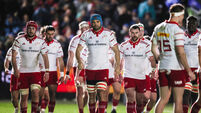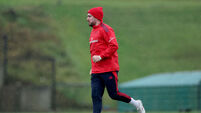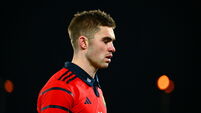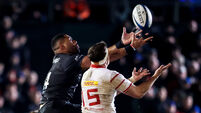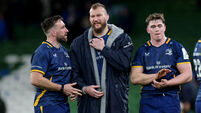RG Snyman aiming to join elite club by returning from second ACL blow
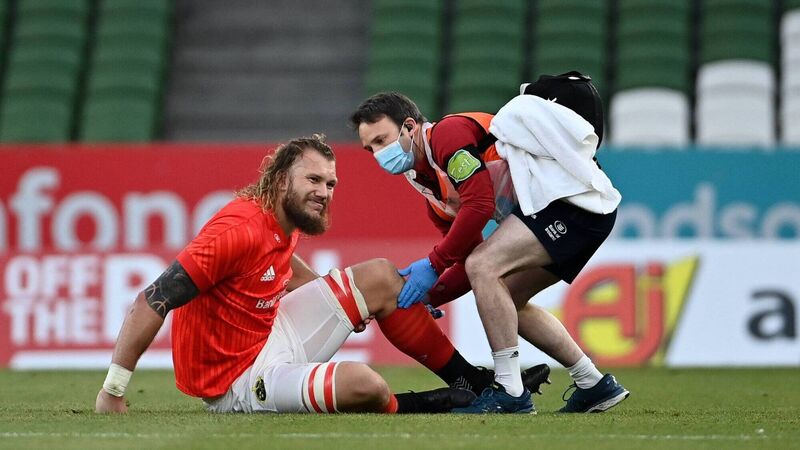
Munster’s RG Snyman after his first injury in 2020. Picture: Ramsey Cardy, Sportsfile
From out of the gloom yesterday came a note of defiance.
“Here I go again,” RG Snyman posted on Instagram. “#round2fight.” And with that the Munster lock had served notice of his determination to overcome this latest bout of misfortune having re-ruptured his cruciate ligament in Sunday’s URC game against Scarlets.
It’s a ridiculously cruel turn of events, not least given the incident sandwiched in between those two knee injuries when he suffered burns in a freak fire pit incident that subsequently required skin graft surgery.
Declan Bowler, a consultant orthopaedic and sports surgeon at the Bon Secours Hospital in Cork, told this paper that the chances of a recurrence ACL injury were in the “single digits” when Snyman first suffered the injury, against Leinster in August of 2020.
So, unlucky he may be, but he is not alone and there is a lengthening history of top-class athletes absorbing that second blow and actually utilising the knowledge base already in place to come back better and stronger.
America, unsurprisingly given its knack for innovation, provides plenty of inspiration. The skier Lindsey Vonn injured the same ACL twice and returned to the peak of her game. So did quarterback Sam Bradford and basketball’s Jabari Parker.
Thomas Davis, a former linebacker, did the same knee three times and still went on to be named to multiple Pro Bowls. So, while some former rugby players here have stressed the mental test that lies ahead, there are others who have leaned into that first setback and used it to rebound.
“This is obviously a very difficult time,” said the soccer star Megan Rapinoe in 2015, “but I do feel super confident in my recovery as I’ve gone through this before and I know what the process will be like.”
This was at a time when the American had suffered a third ACL injury and the last six years stand as proof that she has been well able to pick up where she left off. Bryan Bulaga, an offensive tackle with the Green Bay Packers when he was struck down, echoed this approach.
“Going through it once, you kind of know the aches and pains that are okay, you know what I mean?” Bulaga said on his way back from a second ACL absence. “The first time through you’re a little nervous.
“You think you’re going to do something to it, and the second time through you just kind of block it out and push through it, and that speeds up the timeline. If you baby it, kind of like I did the first time, it may set things back a little bit farther.
“Not a setback, but the timeline gets pushed a little bit because you’re not doing what you should be doing in a good timeframe. So I feel like this time through, we pushed through some things really early, and we started activity early, which helped.”
Bulaga came back three months quicker the second time around and, as Bowler pointed out, professional athletes have access to the best surgeons and rehab programmes possible. None of which is to say that coming back from this is easy.
The ACL is, as the name suggests, a crucial component in the knee. It maintains the joint’s stability, especially when twisting and turning. Seven months is the average return-to-play period but it isn’t just about the ACL.
Injuries like Snyman’s result in a tear to the meniscal tissue, which acts as a shock absorber, somewhere between 50-70% of the time. These tears can be obvious or subtle but they need attention if arthritis isn’t to be a factor later on in life. Even the grafts used to repair the damage can differ.
A study published in the American Journal of Sports Medicine last year, among whose authors were Eanna Falvey and Ray Moran, found that 1.3% of those with patellar tendon grafts and 8.3% of those with hamstring grafts experienced ipsilateral rerupture.
That is, repeat ruptures on the same side.
“So technically there are loads of ways of doing it,” Bowler said last year. “The principles are to repair the damage that is done elsewhere in the knee and give them a graft that allows them to return to play, which happens thankfully nearly 80% of the time.
“But you also have to minimise the risks of it happening again. The chance of it tearing again would be in single digits but you can also tear the other side. So there is a lot of variables that you have to discuss and explain to the patient.”
Kerry footballer David Moran has been here before. Cork’s Colm O’Neill suffered three ACLs in the space of five years but won an All Star after the second. Irish football international Rianna Jarrett suffered three before the age of 22 and came back.
Snyman seems determined to join the club.




